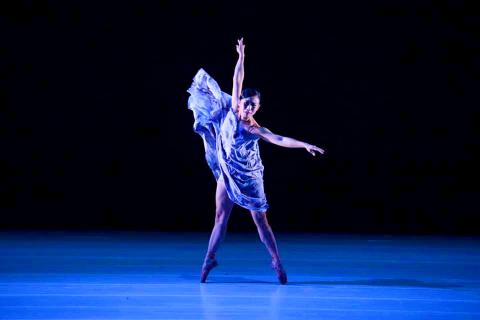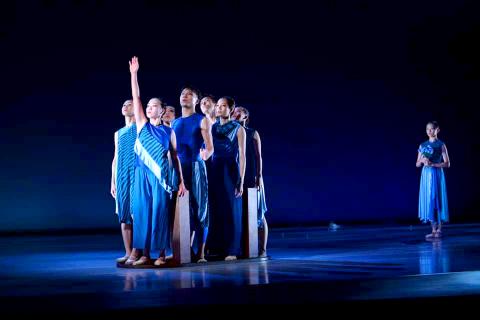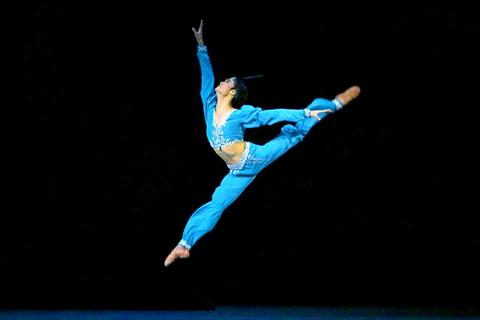It is rare that Taipei sees two ballet companies from St Petersburg, Russia, in the National Theater almost back-to-back, but Management of New Arts (MNA) booked the legendary Mariinsky Theatre Ballet Company into the theater for four performances of Swan Lake from July 18 to July 20, while udnFunLife scheduled the St Petersburg Ballet Theatre from Thursday to Sunday with two performances of La Bayadere and two of Swan Lake.
Just looking at the numbers, it would not seem like much of a contest. The Mariinsky’s history dates back more than 275 years, the St Petersburg Ballet is just 25: the Mariinsky has more than 220 dancers, the other about 60; the Mariinsky travels with its own orchestra and dance floor, the latter hires orchestras in each city.
Yet it was the underdog that gave the more exciting show, albeit not without some major flaws, but with all the passion that was lacking in the Mariinsky’s performance.

Photo courtesy of Liu Ren-haur
Ironically, it was all down to one dancer, a guest artist who is a principal dancer with the Mariinsky: South Korean Kim Ki-men, who danced the role of the warrior Solor.
The 26-year old was spectacular, soaring over the stage in his grand jetes, while nailing the very difficult double assembles en manege.
He gets such great elevation in his jumps and turns, and is so exciting to watch, that he reminded me of the first time I saw Mikhail Baryshnikov dance with the American Ballet Theater at Washington’s Kennedy Center.

Photo courtesy of Liu Ren-haur
Kim was a great partner for St Petersburg’s prima ballerina, Irina Kolesnikova, who was as excellent as expected, and matched her dramatic performance.
Unfortunately, with the exception of Natalia Kleymenova, who danced the role of Gamzatti, soloists Margarita Avdeeva, Yelyzaveta Barkalova and Iana Cherkashina, and Seiyu Ogasawara as the Golden Idol, the rest of the company was uninspiring.
SHAKEY CORPS

Photo courtesy of the Mariinsky Theatre Ballet
While Mariinsky’s corps de ballet was flawless in Swan Lake, St Petersburg’s 24 dancers left a lot to be desired, and in the Kingdom of the Shades scene, which demands absolute synchronization, especially in the arabesque holds, there were a few dancers who were wobbling so badly in the back row I feared they might actually do a collective face plant.
Most shocking, however, was the appearance of the Golden Idol — a Soviet-era addition to La Bayadere — whose eight minions, all local ballet students, were in blackface.
It might seem a minor point in a ballet filled with Western tropes and cliches about India and “the exotic East,” but in this day and age, there is no need for dancers to be painted black from head to toe. After all, the rest of the cast was not made up to look “Indian.”
It is simply appalling and something that Russian companies need to stop doing.
The St Petersburg Ballet Theatre will be at the National Taichung Theater this weekend with Swan Lake. The performances are sold out.
KAOHSIUNG CITY BALLET
Down in Kaohsiung on Saturday night, the Kaohsiung City Ballet (KCB, 高雄城市芭蕾舞團) staged its latest production, Water (水), at the National Kaohsiung Center for the Arts’ Playhouse.
The double bill features works by Romanian ballet choreographer Constantin Georgescu and Kaohsiung-born contemporary dancer Wang Kuo-chuan (王國權) that shared the same title, but could not have been more different in style and tempo.
Georgescu’s nine-sectioned dance, set on seven dancers, explores the different states in which water can exist, such as rain, ice, sweat, waves and blood, with a mixture of solos, duets and group dances, set to an eclectic selection of eight modern musical works.
It is a light, enjoyable piece, that while not breaking any new ground, kept this viewer engaged.
Wang’s six-movement dance was dramatically different, darker in tone and scale. He took full advantage of the height and facilities of the Playhouse stage to incorporate aerial work and some dramatic billowing cloth drops, something that KCB’s usual venues do not allow for.
His seven dancers were led by the amazing Ally Yeh (葉麗娟), still wonderful to watch at 53, and obviously game for anything, as she was lifted, twisted and carried aloft by male colleagues half her age.
His score choices ranged from Max Bruch’s Scottish Fantasy to string quartets by Michael Nyman and A Walk in the Palace Gardens by Natacha Atlas and Samy Bishai, which provided a rich backdrop to Wang’s emotionally charged choreography.
KCB will give two more performances of Water, on Aug. 24 at the Pingtung County Art Center and on Aug. 27 at the National Taichung Theater.

May 26 to June 1 When the Qing Dynasty first took control over many parts of Taiwan in 1684, it roughly continued the Kingdom of Tungning’s administrative borders (see below), setting up one prefecture and three counties. The actual area of control covered today’s Chiayi, Tainan and Kaohsiung. The administrative center was in Taiwan Prefecture, in today’s Tainan. But as Han settlement expanded and due to rebellions and other international incidents, the administrative units became more complex. By the time Taiwan became a province of the Qing in 1887, there were three prefectures, eleven counties, three subprefectures and one directly-administered prefecture, with

It’s an enormous dome of colorful glass, something between the Sistine Chapel and a Marc Chagall fresco. And yet, it’s just a subway station. Formosa Boulevard is the heart of Kaohsiung’s mass transit system. In metro terms, it’s modest: the only transfer station in a network with just two lines. But it’s a landmark nonetheless: a civic space that serves as much more than a point of transit. On a hot Sunday, the corridors and vast halls are filled with a market selling everything from second-hand clothes to toys and house decorations. It’s just one of the many events the station hosts,

Among Thailand’s Chinese Nationalist Party (KMT) villages, a certain rivalry exists between Arunothai, the largest of these villages, and Mae Salong, which is currently the most prosperous. Historically, the rivalry stems from a split in KMT military factions in the early 1960s, which divided command and opium territories after Chiang Kai-shek (蔣介石) cut off open support in 1961 due to international pressure (see part two, “The KMT opium lords of the Golden Triangle,” on May 20). But today this rivalry manifests as a different kind of split, with Arunothai leading a pro-China faction and Mae Salong staunchly aligned to Taiwan.

Two moves show Taichung Mayor Lu Shiow-yen (盧秀燕) is gunning for Chinese Nationalist Party (KMT) party chair and the 2028 presidential election. Technically, these are not yet “officially” official, but by the rules of Taiwan politics, she is now on the dance floor. Earlier this month Lu confirmed in an interview in Japan’s Nikkei that she was considering running for KMT chair. This is not new news, but according to reports from her camp she previously was still considering the case for and against running. By choosing a respected, international news outlet, she declared it to the world. While the outside world